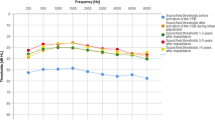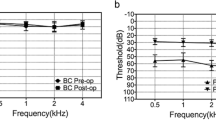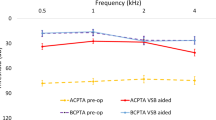Abstract
The aim of this pilot study was to determine the acceptance and benefit from the middle ear implant system Vibrant Soundbridge® (VSB, MED-EL Corporation, Austria) by means of a questionnaire, compared to a previously used conventional bone conducting hearing device, in preschool children with unilateral congenital aural atresia. Prospective cohort study. All nine children with unilateral congenital aural atresia used the VSB and had previous experience with a bone conducting hearing device. The benefit from the VSB was evaluated by questionnaires concerning acceptance of hearing aids, handling, listening effort, behavior, quality of life, and the duration of daily use and compared to the experience with the bone conducting hearing device. In addition, to quantify the benefit from the VSB use, audiological assessment (pure-tone audiometry via free field testing, speech audiometry, and localization test) was performed with and without VSB. The questionnaires and audiological test results were compared pairwise. According to all questionnaire areas, children benefited significantly more from the VSB compared to bone conducting hearing device (ps <.05). The most important finding was a significant increase in daily use from 2 h for the bone conducting hearing device to 10 h for the VSB. Children performed significantly better with the VSB than without it in the audiological assessment. Children with unilateral aural atresia benefited significantly more from the VSB compared to a conventional bone conducting hearing device according to the parents’ questionnaires and yielded better results in the audiometry and localization test with the VSB than without it.


Similar content being viewed by others
References
Frenzel H, Schönweiler R, Hanke F, Steffen A, Wollenberg B (2012) The Lübeck flowchart for functional and aesthetic rehabilitation of aural atresia and microtia. Otol Neurotol 33(8):1363–1367
Ito K (1998) Can unilateral hearing loss be a handicap in learning? Arch Otolaryngol Head Neck Surg 124(12):1389–1390
Keller WD, Bundy RS (1980) Effects of unilateral hearing loss upon educational achievement. Child Care Health Dev 6(2):93–100
Kunst SJ, Leijendeckers JM, Mylanus EA, Hol MK, Snik AF, Cremers CW (2008) Bone-anchored hearing aid system application for unilateral congenital conductive hearing impairment: audiometric results. Otol Neurotol 29(1):2–7
Priwin C, Jonsson R, Magnusson L, Hultcrantz M, Granstrom G (2007) Audiological evaluation and self-assessed hearing problems in subjects with single-sided congenital external ear malformations and associated conductive hearing loss. Int J Audiol 46(4):162–171
Lieu JE, Tye-Murray N, Fu Q (2012) Longitudinal study of children with unilateral hearing loss. Laryngoscope 122(9):2088–2095
Morita S, Suzuki M, Iizuka K (2010) Non-organic hearing loss in childhood. Int J Pediatr Otorhinolaryngol 74(5):441–446
Tharpe AM, Sladen DP (2008) Causation of permanent unilateral and mild bilateral hearing loss in children. Trends Amplif 12(1):17–25
Sharma A, Dorman M, Kral A (2005) The influence of a sensitive period on central auditory development in children with unilateral and bilateral cochlear implants. Hear Res 203(1–2):134–143
Lieu JE, Tye-Murray N, Karzon RK, Piccirillo JF (2010) Unilateral hearing loss is associated with worse speech-language scores in children. Pediatrics 125(6):1348–1355
Lieu JE, Karzon RK, Ead B, Tye-Murray N (2013) Do audiologic characteristics predict outcomes in children with unilateral hearing loss? Otol Neurotol 34(9):1703–1710
Swartz JD, Faerber EN (1985) Congenital malformations of the external and middle ear: high resolution CT findings of surgical import. AJR Am J Roentgenol 144(3):501–506
Ishimoto S, Ito K, Karino S et al (2007) Hearing levels in patients with microtia: correlation with temporal bone malformation. Laryngoscope 117(3):461–465
Luetje CM, Brackman D, Balkany TJ et al (2002) Phase III clinical trial results with the Vibrant Soundbridge implantable middle ear hearing device: a prospective controlled multicenter study. Otolaryngol Head Neck Surg 126(2):97–107
Sterkers O, Boucarra D, Labassi S et al (2003) A middle ear implant, the Symphonix Vibrant Soundbridge: retrospective study of the first 125 patients implanted in France. Otol Neurotol 24(3):427–436
Colletti V, Soli SD, Carner M, Colletti L (2006) Treatment of mixed hearing losses via implantation of a vibratory transducer on the round window. Int J Audiol 45(10):600–608
Mandala M, Colletti L, Colletti V (2011) Treatment of the atretic ear with round window Vibrant Soundbridge implantation in infants and children: electrocochleography and audiologic outcomes. Otol Neurotol 32(8):1250–1255
Frenzel H, Hanke F, Beltrame M, Wollenberg B (2010) Application of the Vibrant Soundbridge in bilateral congenital atresia in toddlers. Acta Otolaryngol 130(8):966–970
Colletti V, Carner M, Sacchetto L (2005) Round window stimulation with the floating mass transducer. A new approach for surgical failures of mixed hearing losses. Presentation at the “XVIII IFOS World Congress”, Rome, Italy
Clarós P, Pujol Mdel C (2013) Active middle ear implants: vibroplasty™ in children and adolescents with acquired or congenital middle ear disorders. Acta Otolaryngol 133(6):612–619
Coninx F (2005) Konstruktion und Normierung des Adaptiven Auditiven Sprach-Test (AAST). Presentation at the conference “22. Wissenschaftliche Jahrestagung der Deutschen Gesellschaft für Phoniatrie und Pädaudiologie”, Berlin, Germany
Cremers CW, O’Connor AF, Helms J et al (2010) International consensus on Vibrant Soundbridge® implantation in children and adolescents. Int J Pediatr Otorhinolaryngol 74(11):1267–1269
Beutner D, Hüttenbrink KB (2009) Passive und aktive Mittelohrimplantate. Laryngo Rhino Otol 88(1):32–47
Wagner JH, Ernst A, Todt I (2011) Magnet resonance imaging safety of the Vibrant Soundbridge system: a review. Otol Neurootol 32(7):1040–1046
Ernst AE, Todt I, Wagner J (2016) Safety and effectiveness of the Vibrant Soundbridge in treating conductive and mixed hearing loss: a systematic review. Laryngoscope 126(6):1451–1457
Volkenstein S, Thomas JP, Dazert S (2016) Implantierbare Knochenleitungs- und aktive Mittelohr-Hörsysteme. Laryngo Rhino Otol 95(05):352–363
Amonoo-Kuofi K, Kelly A, Neeff M, Brown CR (2015) Experience of bone-anchored hearing aid implantation in children younger than 5 years of age. Int J Pediatr Otorhinolaryngol 79(4):474–480
Lloyd S, Almeyda J, Sirimanna KS, Albert DM, Bailey CM (2007) Updated surgical experience with bone-anchored hearing aids in children. J Laryngol Otol 121(9):826–831
Heuermann H, Kinkel M, Tchorz J (2005) Comparison of psychometric properties of the International Outcome Inventory for Hearing Aids (IOI-hA) in various studies. Int J Audiol 44(2):102–109
Frenzel H, Hanke F, Beltrame M, Steffen A, Schönweiler R, Wollenberg B (2009) Application of the Vibrant Soundbridge to unilateral osseous atresia cases. Laryngoscope 119(1):67–74
Löhler J, Moser L, Heinrich D, Hörmann K, Walther LE (2012) Klinische Ergebnisse bei der Anwendung des APHAB (deutsche Version) in der Hörgeräteversorgung. HNO 60(7):626–636
Author information
Authors and Affiliations
Corresponding author
Ethics declarations
Conflict of interest
The authors declare that they have no conflict of interest.
Ethical approval
All procedures performed in studies involving human participants were in accordance with the ethical standards of the institutional and/or national research committee and with the 1964 Helsinki declaration and its later amendments or comparable ethical standards.
Informed consent
Informed consent was obtained from all individual participants included in the study. Earlier results of this study were reported by Barbara Vaerst, Yevgen Zaretsky, Martin Leinung, Timo Stöver, and Christiane Hey at the 85th Annual Meeting of the German Society of Oto-Rhino-Laryngology, Head and Neck Surgery, 28.05-01.06.2014, Dortmund, Germany, in an oral presentation “Versorgung von unilateralen Gehörgangsatresien bei Vorschulkindern mit einer Vibrant Soundbridge®: Erfassung der Versorgungsqualität”.
Additional information
M. Leinung and E. Zaretsky contributed equally to this work.
Rights and permissions
About this article
Cite this article
Leinung, M., Zaretsky, E., Lange, B.P. et al. Vibrant Soundbridge® in preschool children with unilateral aural atresia: acceptance and benefit. Eur Arch Otorhinolaryngol 274, 159–165 (2017). https://doi.org/10.1007/s00405-016-4265-1
Received:
Accepted:
Published:
Issue Date:
DOI: https://doi.org/10.1007/s00405-016-4265-1




